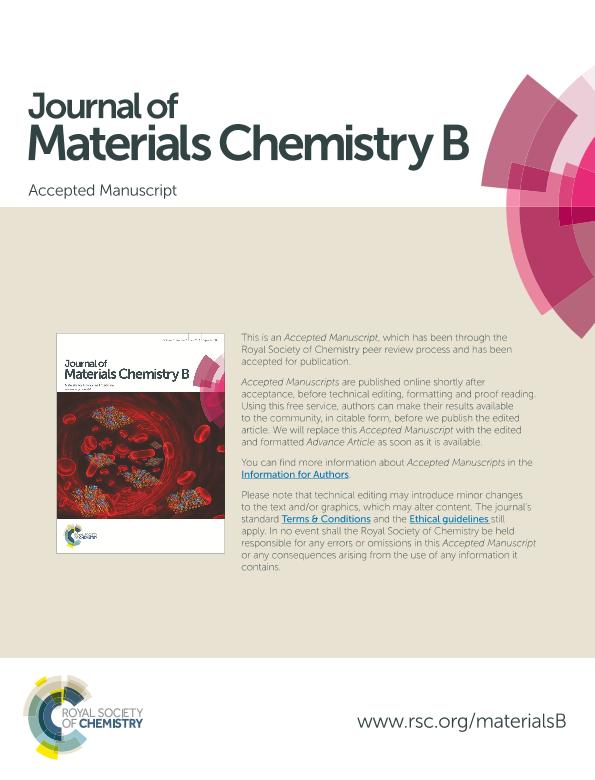Mostrar el registro sencillo del ítem
dc.contributor.author
Seremeta, Katia Pamela

dc.contributor.author
Höcht, Christian
dc.contributor.author
Taira, Carlos Alberto

dc.contributor.author
Cortez Tornello, Pablo Roberto

dc.contributor.author
Abraham, Gustavo Abel

dc.contributor.author
Sosnik, Alejandro Dario

dc.date.available
2016-07-19T19:16:25Z
dc.date.issued
2015-08
dc.identifier.citation
Seremeta, Katia Pamela; Höcht, Christian; Taira, Carlos Alberto; Cortez Tornello, Pablo Roberto; Abraham, Gustavo Abel; et al.; Didanosine-loaded poly(epsilon-caprolactone) microparticles by a coaxial electrohydrodynamic atomization (CEHDA) technique; Royal Society of Chemistry; Journal Of Materials Chemistry B; 3; 1; 8-2015; 102-111
dc.identifier.issn
2050-7518
dc.identifier.uri
http://hdl.handle.net/11336/6592
dc.description.abstract
The goal of this study was to investigate the electrohydrodynamic atomization (EHDA) technology to encapsulate the water-soluble antiretroviral didanosine (ddI) within poly(epsilon-caprolactone) (PCL) particles and stabilize it in the gastric medium where it undergoes fast degradation. A preliminary study employing a one-needle setup enabled the adjustment of the critical process parameters. Then, a configuration of two concentric needles named coaxial electrohydrodynamic atomization (CEHDA) led to the formation of ddI-loaded PCL microcapsules. Scanning electron microscopy analysis showed that the microparticles were spherical and with narrow size distribution. Attenuated total reflectance/Fourier transform infrared spectroscopy confirmed that most of the drug was efficiently encapsulated within the particles, whereas differential scanning calorimetry and X-ray powder diffraction revealed that the drug was preserved mainly in crystalline form. The loading capacity was relatively high (approximately 12% w/w), and the encapsulation efficiency was approximately 100%. In vitro release assays (PBS pH ¼ 7.4) indicated that ddI was released almost completely within 2 h. Moreover, the delayed release was expected to isolate ddI from the biological fluids during the gastric transit. Finally, pharmacokinetics studies in rats showed that ddI-loaded particles lead to a statistically significant increase of the oral bioavailability of almost 4 times and a 2-fold prolongation of the half-life with respect to a ddI aqueous solution, supporting the use of CEHDA as a promising reproducible, scalable and cost-viable technology to encapsulate water-soluble drugs within polymeric particles.
dc.format
application/pdf
dc.language.iso
eng
dc.publisher
Royal Society of Chemistry

dc.rights
info:eu-repo/semantics/openAccess
dc.rights.uri
https://creativecommons.org/licenses/by-nc-sa/2.5/ar/
dc.subject
Hiv/Aids
dc.subject
Didanosine
dc.subject
Poly(Epsilon-Caprolactone)
dc.subject
Electrohydrodynamic Atomization
dc.subject.classification
Ingeniería de los Materiales

dc.subject.classification
Ingeniería de los Materiales

dc.subject.classification
INGENIERÍAS Y TECNOLOGÍAS

dc.subject.classification
Bioproductos, Biomateriales, Bioplásticos, Biocombustibles, Bioderivados, etc.

dc.subject.classification
Biotecnología Industrial

dc.subject.classification
INGENIERÍAS Y TECNOLOGÍAS

dc.title
Didanosine-loaded poly(epsilon-caprolactone) microparticles by a coaxial electrohydrodynamic atomization (CEHDA) technique
dc.type
info:eu-repo/semantics/article
dc.type
info:ar-repo/semantics/artículo
dc.type
info:eu-repo/semantics/publishedVersion
dc.date.updated
2016-05-03T14:57:33Z
dc.journal.volume
3
dc.journal.number
1
dc.journal.pagination
102-111
dc.journal.pais
Reino Unido

dc.journal.ciudad
Cambridge
dc.description.fil
Fil: Seremeta, Katia Pamela. Universidad de Buenos Aires. Facultad de Farmacia y Bioquímica. Departamento de Tecnología Farmacéutica; Argentina. Consejo Nacional de Investigaciones Científicas y Técnicas. Oficina de Coordinación Administrativa Houssay; Argentina
dc.description.fil
Fil: Höcht, Christian. Universidad de Buenos Aires. Facultad de Farmacia y Bioquímica. Departamento de Farmacología; Argentina
dc.description.fil
Fil: Taira, Carlos Alberto. Universidad de Buenos Aires. Facultad de Farmacia y Bioquímica. Departamento de Farmacología; Argentina. Consejo Nacional de Investigaciones Científicas y Técnicas. Oficina de Coordinación Administrativa Houssay; Argentina
dc.description.fil
Fil: Cortez Tornello, Pablo Roberto. Consejo Nacional de Investigaciones Científicas y Técnicas. Centro Científico Tecnológico Mar del Plata. Instituto de Investigación En Ciencia y Tecnología de Materiales (i); Argentina
dc.description.fil
Fil: Abraham, Gustavo Abel. Consejo Nacional de Investigaciones Científicas y Técnicas. Centro Científico Tecnológico Mar del Plata. Instituto de Investigación En Ciencia y Tecnología de Materiales (i); Argentina
dc.description.fil
Fil: Sosnik, Alejandro Dario. Technion-Israel Institute of Technology. Department of Materials Science and Engineering. Group of Pharmaceutical Nanomaterials Science; Israel
dc.journal.title
Journal Of Materials Chemistry B
dc.relation.alternativeid
info:eu-repo/semantics/altIdentifier/url/http://pubs.rsc.org/en/Content/ArticleLanding/2015/TB/c4tb00664j
dc.relation.alternativeid
info:eu-repo/semantics/altIdentifier/doi/10.1039/C4TB00664J
dc.relation.alternativeid
info:eu-repo/semantics/altIdentifier/doi/http://dx.doi.org/10.1039/C4TB00664J
Archivos asociados
